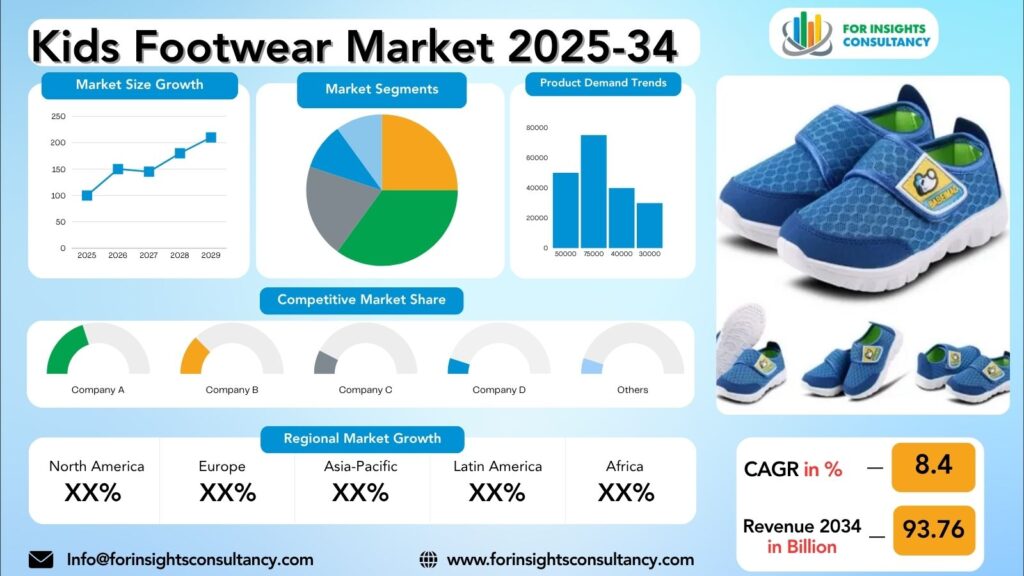
Kids Footwear Market Size, Trends Analysis Research Report By Product Type (Athletic, Casual, Formal, Sandals, Toddler, Others), by material (Leather, Synthetic Leather, Textile, Rubber, Others), by End-Use/Age Group, by Distribution Channel, and By Region Global Market Analysis And Forecast, 2025-2034
Oct-2025 Formats | PDF | Category: Consumer Goods | Delivery: 24 to 72 Hours
Global revenue from the Kids Footwear market is predictable at US$ 54.89 Billion in 2025 and has been forthright to current at a CAGR of 8.4% to extent US$ 93.76 Billion by the end of 2034.
Kids Footwear Market Research Summary
The kid’s footwear market is a vibrant sector that tailors its offer to the particular requirements and tastes of the young buyers. This in-depth article provides an insight into the main trends, challenges, and opportunities that determine the market’s landscape.
Brands must understand the changing needs of kids and parents if they want to keep their position in the market. In the kids’ footwear segment, factors like comfort, durability, and style are the main drivers of purchase decisions.
The industry is gradually turning to the production of sustainable and morally justified footwear. Consumers who are concerned about the environment are more inclined to buy from brands that take care of the earth in terms of both materials and processes.
The competition to win the consumers’ loyalty is fierce among both worldwide and home-grown contenders as they try to outdo each other with cutting-edge designs, the ability to customize, and marketing strategies that create a rapport with the young target market.
Technological innovations such as 3D printing for custom shoes, smart features for added comfort, and augmented reality for an interactive shopping experience may alter the trajectory of the children’s footwear industry.
Brands that foresee these trends and are willing to innovate can be among the winners in this competitive market.
Market Insights
- In 2024, the Kids Footwear Market is expected to see significant growth, with the Asia-Pacific region leading in regional revenue share, followed by North America and Europe.
- The Asia-Pacific region is forecasted to have the largest share of revenue due to the increasing population and rising disposable income in countries like China and India.
- In the U.S., around 82% of the population is expected to reside in urban areas by 2024, driving demand for stylish and comfortable kids’ footwear.
- The segments that are projected to have the largest revenue share in the Kids Footwear Market include sneakers, sandals, and boots, as these categories remain popular among children and parents alike.
Market Dynamics
Trends
Sustainability and Eco-Friendly Materials: There is a notable shift towards the use of sustainable and environmentally friendly materials in kids footwear, this is mainly due to the increased consumer awareness and demand for products that are eco-friendly.
Technological Innovations: Kid’s footwear is the next area where technology can be implemented. In this case, smart features to track activity levels or ensure the correct fit may be included to appeal to the tech-savvy younger generation.
Fashion and Personalization: The trend of stylish and personalized children’s footwear has risen tremendously, thus the availability of customization options such as colors, designs, and even initials enabling kids to identify their uniqueness through their shoes.
Comfort and Functionality: The designs of kids’ footwear emphasize comfort and functionality by using breathable materials, incorporating supportive features, and making the shoes with durable construction to ensure foot health and the overall well-being of children.
Online Retail and Direct-to-Consumer Sales: There has been a move towards online retail and direct-to-consumer sales channels for kids footwear, thus providing parents with the convenience of shopping and a wider range of options.
Growth Drivers
Parents are having more money to spend on their children as the disposable income of parents is on the rise. As a result, spending on quality shoes for children is increasing.
Awareness to support the feet properly and development in the case of children has become the main reason to the demand for specialized kids’ footwear.
There has been a great innovation in the design and materials, and hence, children’s shoes have become more durable, comfortable, and stylish, which in turn has attracted more consumers.
The trend of children’s fashion and the impact of social media, thus, determining the preferences and resulting in the increase of sales, have been more and more talked about.
There has been a great development in the online retail channels and e-commerce platforms, which has made the shopping experience more convenient for parents and has given a wider reach to brands in the kids’ footwear market.
Restraints
Economic Uncertainty: A fluctuating economy could cause a reduction in consumer spending, thus children footwear might be regarded as a non-essential item and be the first to be cut out of the budget.
Supply Chain Disruptures: The supply chain disruptions resulting from challenges in the transportation of goods or production issues may cause the lack of products in stores.
Changing Fashion Trends: Fast changing fashion trends can lead to the company stocking up on products that quickly become outdated resulting in excess stock.
Competition from Alternatives: The rise of competition in different categories such as online retailers and second-hand marketplaces where consumers can buy children footwear is likely to cause a decline in sales of the traditional kids footwear industry.
Regulatory Changes: The alterations in regulations concerning manufacturing practices, materials, or safety standards may have an effect on production costs and pricing strategies of kids footwear brands.
Opportunities
Growing Demand: The trend of focusing on children’s fashion and the willingness of parents to spend on quality footwear open a great growth possibility for the market.
Technological Advancements: The use of technology in kids’ shoes, for example, smart features that can be used for tracking activity levels or growth, may help to drive innovation and attract tech-savvy parents.
Sustainable Footwear: As the world becomes more environmentally conscious, the need for environmentally friendly and sustainable footwear for children will also go up, thus, giving the brands that focus on sustainability the advantage to attract more customers.
E-commerce Growth: The development of online shopping platforms is a convenient way for parents to shop for kids’ footwear and thus, it creates new means for market expansion and getting access to more customers.
Customization Trends: The demand for personalized and customizable footwear for children is gaining popularity and therefore, offers unique opportunities for brands to serve individual preferences and styles.
Challenges
Changing Consumer Preferences: It is quite hard for footwear brands to always be on point with the changing tastes and preferences of both children and their parents.
Competition from Online Retailers: The emergence of e-commerce platforms has heated up the competition for brick-and-mortar stores selling kids’ footwear.
Sustainability and Ethical Practices: The rise in demand for sustainable and ethically produced footwear products is a challenge for manufacturers.
Economic Uncertainty: The ups and downs of the economy can affect the consumers’ decision to spend on non-essential items like kids’ footwear.
Supply Chain Disruptions: The pandemic, for instance, or any other global event like a natural disaster, can disrupt the supply chain, thus, causing delays in the production and distribution of kids’ footwear.
Kids Footwear Market Top Companies Covered In This Report:
Evaluate The Strategic Positioning And Innovation Pipelines Of Leading Market Companies-From Multinational Enterprises To Disruptive Regional Firms. Understand How Key Players Are Innovating, Expanding, And Capturing Value, And Use Competitive Benchmarks To Plan Your Next Move.
- Stride Rite
- Nike, Inc.
- The Children’s Place
- Crocs Retail, LLC
- New Balance
- See Kai Run
- Puma SE
- ASICS Corporation
- SKECHERS USA, Inc.
- adidas AG
Kids Footwear Market Company News 2024 and 2025
Crocs, Inc
In February 2025, Crocs reported full-year 2024 revenue of US$4.1 billion (up ~4 % over 2023) and emphasised strong operating cash flow and shareholder returns.
See Kai Run
In June 2025 the brand was acquired by Fundamental Capital, signalling a change in ownership and potential strategic direction for its toddler/children’s footwear business.
Key Segments
Segmentation By Product Type
- Athletic/Sports Shoes
- Casual Shoes
- Formal Shoes
- Sandals/Flip-flops
- Toddler Shoes
- Others
Segmentation By Material
- Leather
- Synthetic Leather
- Textile
- Rubber
- Others
Segmentation By Age Group
- Under 3 Years
- 3-6 Years
- 6-14 Years
Segmentation By Gender
- Boys
- Girls
- Unisex
Segmentation ByDistribution Channel
- Online Retail
- Specialty Stores
- Department Stores/Supermarkets & Hypermarkets
- Offline Retail (Traditional Stores)
Global Geographic Coverage:
The Report Provides In-Depth Qualitative And Quantitative Data On The Kids Footwear Market For All Of The Regions And Countries Listed Below:
North America
The kids footwear market in North America is expected to maintain an upward trend over the next few years. This development is positively impacted by the region’s GDP growth and low inflation rates. In the US, one such local driver that distinctly influences the market is the Back-to-School sales tax holidays that help parents by making their purchases of footwear for their children less costly. This singular government subsidy propels sales to a great extent during the back-to-school period.
Consumer kids footwear in North America is mostly done through retail stores, whereas online sales, which are reflecting the growing trend of e-commerce in the region, are the fastest-growing channel. Consumers are increasingly demanding sustainability and ethical sourcing practices in their products, thus making these factors a necessity for a large number of customers. Nevertheless, in several emerging markets where price and status are the most important, localism and ethical considerations might be relegated to the background in favor of affordability and brand recognition.
Europe
The market for children’s footwear in Europe is a rapidly changing and fiercely competitive industry with a projected GDP growth rate of 2.1% and an inflation rate of 1.8%. Spain’s government subsidy program for shoe purchases by families with children has thus had a considerable positive effect on sales in the area, making it a major market driver. Although kids’ footwear in Europe is still mainly sold through brick-and-mortar stores, online retail is the fastest-growing channel due to its convenience and wide product variety. Customers in Europe are becoming more and more focused on the sustainability and ethical sourcing of the kids footwear they purchase, thus it being a must-have for many. However, in emerging markets where price and status are the most important, factors such as sustainability may be less prioritized in purchasing decisions. The different sub-regions of Europe each have distinct opportunities and obstacles for kids’ footwear brands that want to increase their market presence.
Asia Pacific
The Kids Footwear Market in Asia Pacific is expected to grow substantially, mainly due to the region’s estimated GDP growth of 5.4% and inflation rate of 2.8%. In Japan, the main factor influencing the market is the cultural tradition of giving children’s shoes as gifts during special ceremonies, thus, sales are increasing. The most influential channel for kids’ footwear in South Korea is online retail, whereas the quickest expanding channel is children’s specialty stores in Australia. Buyers in India focus on ethical sourcing and sustainability, thus, it is a necessity that brands incorporate these aspects if they want to be successful in this market. In several emerging markets like Indonesia and Thailand, price and status still being the major factors for consumer preferences, therefore, there are still possibilities for mid-range and luxury brands to flourish.
Middle East and Africa
The Middle East and Africa Kids Footwear Market is expected to have a projected GDP Growth of approximately 3.5% with an inflation rate of 5%. In Saudi Arabia, a single government subsidy for the local manufacturing of children’s shoes is a significant non-replicable driver changing the consumer preference for domestically produced goods. The main sales channel for kids’ footwear in the region is brick-and-mortar stores, while e-commerce is the quickest growing channel because of the rising digital adoption among consumers.
Consumers in Egypt care most about sustainability and ethical sourcing when buying children’s footwear. On the other hand, in markets like Nigeria and South Africa, the price and status have a much more significant impact on the purchasing decisions. Localism is great in Morocco and Kenya, where it mirrors the consumers’ preference for locally-made products. The region’s emerging markets tend to focus on affordability and brand perception rather than sustainability practices.
Frequently Asking Questions
What is the Kids Footwear market size and growth forecast?
Kids Footwear Market is predicted to grow from USD 54.89 Billion in 2025 to approximately USD 93.76 Billion by 2034. the industry is estimated to expand at a CAGR of 8.4%.
Who are the key players in the Kids Footwear market?
The Kids Footwear Market Includes Major Companies Stride Rite, Nike, Inc., The Children’s Place, Crocs Retail, LLC, New Balance, See Kai Run, Puma SE, ASICS Corporation, SKECHERS USA, Inc., adidas AG, Others.
What are the current and future trends for Kids Footwear market?
Current Trend: Growing demand for sustainable and eco-friendly kids’ footwear options.
Future Trend: Increased focus on technology integration and customization in kids’ footwear designs.
What are the challenges facing the Kids Footwear market?
One of the challenges facing the Kids Footwear market is keeping up with changing fashion trends and preferences of children.
Which regions dominate the Kids Footwear market?
North America dominates the kids footwear market, followed by Asia-Pacific as the fastest-growing region.
Report Features
This report gives the most complete information. The report on Kids Footwear Market format has been designed so that it can provide the best value to the business. It offers crucial insights into the market’s dynamic and will aid in strategic decision-making for current players as well as those looking to join the market.
What Deliverables Will You Get in this Report?
|
Key questions this report answers |
Relevant contents in the report |
|
How big is the sales opportunity? |
In-depth analysis of the Global Kids Footwear
Market |
|
How lucrative is the future? |
Market forecast and trend data and emerging
trends |
|
Which regions offer the best sales opportunities? |
Global, regional and country level historical
data and forecasts |
|
Which are the most attractive Kids Footwear
market Key segments? |
Market segment analysis and |
|
Which are the top Key players and Their Kids
Footwear market positioning? |
Competitive landscape analysis, Market share
analysis |
|
How complex is the business environment? |
Porter’s five forces analysis, PEST analysis, Life
cycle analysis |
|
What are the factors affecting the Kids Footwear
market? |
Drivers & Restraints |
|
Will I get the information on my |
Customized Report as per your Business
Needs Our analysts will work directly with you and
understand your needs Get data on specified regions or segments,
competitor and Vendors Data will be formatted and presented as per your
requirements Any Requirement Contact Us: Https://Www.Forinsightsconsultancy.Com/Contact-Us |
Table of Contents
For TOC Contact us: https://forinsightsconsultancy.com/contact-us/






